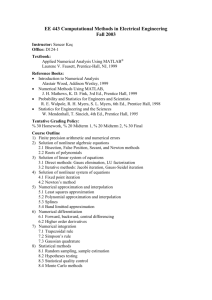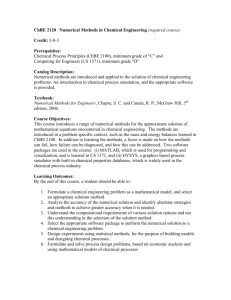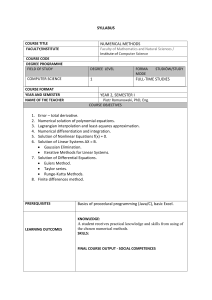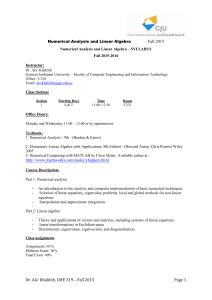CE 100 Elementary Fluid Mechanics
advertisement
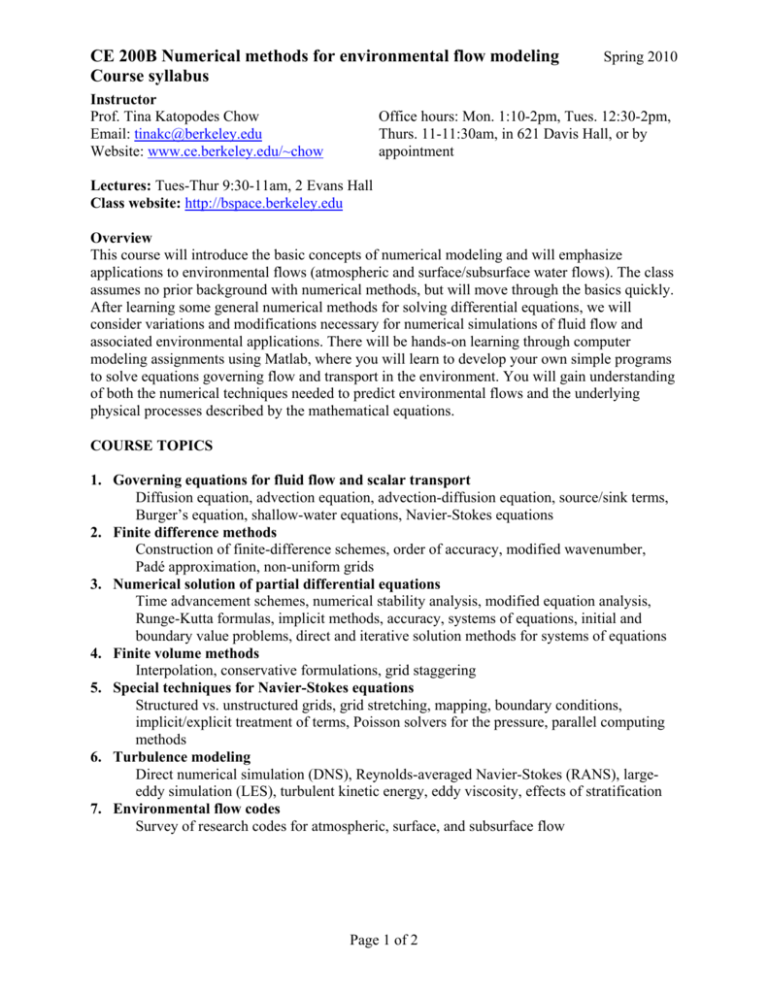
CE 200B Numerical methods for environmental flow modeling Course syllabus Instructor Prof. Tina Katopodes Chow Email: tinakc@berkeley.edu Website: www.ce.berkeley.edu/~chow Spring 2010 Office hours: Mon. 1:10-2pm, Tues. 12:30-2pm, Thurs. 11-11:30am, in 621 Davis Hall, or by appointment Lectures: Tues-Thur 9:30-11am, 2 Evans Hall Class website: http://bspace.berkeley.edu Overview This course will introduce the basic concepts of numerical modeling and will emphasize applications to environmental flows (atmospheric and surface/subsurface water flows). The class assumes no prior background with numerical methods, but will move through the basics quickly. After learning some general numerical methods for solving differential equations, we will consider variations and modifications necessary for numerical simulations of fluid flow and associated environmental applications. There will be hands-on learning through computer modeling assignments using Matlab, where you will learn to develop your own simple programs to solve equations governing flow and transport in the environment. You will gain understanding of both the numerical techniques needed to predict environmental flows and the underlying physical processes described by the mathematical equations. COURSE TOPICS 1. Governing equations for fluid flow and scalar transport Diffusion equation, advection equation, advection-diffusion equation, source/sink terms, Burger’s equation, shallow-water equations, Navier-Stokes equations 2. Finite difference methods Construction of finite-difference schemes, order of accuracy, modified wavenumber, Padé approximation, non-uniform grids 3. Numerical solution of partial differential equations Time advancement schemes, numerical stability analysis, modified equation analysis, Runge-Kutta formulas, implicit methods, accuracy, systems of equations, initial and boundary value problems, direct and iterative solution methods for systems of equations 4. Finite volume methods Interpolation, conservative formulations, grid staggering 5. Special techniques for Navier-Stokes equations Structured vs. unstructured grids, grid stretching, mapping, boundary conditions, implicit/explicit treatment of terms, Poisson solvers for the pressure, parallel computing methods 6. Turbulence modeling Direct numerical simulation (DNS), Reynolds-averaged Navier-Stokes (RANS), largeeddy simulation (LES), turbulent kinetic energy, eddy viscosity, effects of stratification 7. Environmental flow codes Survey of research codes for atmospheric, surface, and subsurface flow Page 1 of 2 CE 200B Numerical methods for environmental flow modeling – Course syllabus Spring 2010 Course objectives By the end of this course, you should be able to: • Derive and apply the basic numerical methods used in 1D, 2D, and 3D numerical models • Estimate the errors and stability of numerical schemes • Program one- or two-dimensional numerical solutions in Matlab • Select and apply appropriate turbulence models for flow simulations • Explain the properties and setup of common numerical codes used for environmental fluid mechanics • Use a 3D model of your choice to investigate an environmental flow problem COURSE LOGISTICS Course website: http://bspace.berkeley.edu The website will be used to post homework assignments and solutions, handouts, etc. An online forum is available to discuss questions with your classmates and instructors. You can also check your grades online. Textbooks: Reading will be assigned from 2 books (on reserve at the Engineering Library): Fundamentals of engineering numerical analysis. Author: Moin, Parviz. Published: Cambridge, U.K.; New York: Cambridge University Press, 2001. Computational methods for fluid dynamics. Authors: Ferziger, Joel H. and Peric, Milovan. Published: Berlin; New York: Springer, 3rd edition, 2002. Other useful references on reserve at Engineering Library: Numerical methods for engineering application. Author: Ferziger, Joel H. Published: New York: Wiley, 2nd edition, 1998. Numerical methods for wave equations in geophysical fluid dynamics. Author: Durran, Dale R. Published: New York: Springer, 1999. Online: http://site.ebrary.com/lib/berkeley/Doc?id=10005872 Homework: Problem sets will be assigned regularly. Late homework will be penalized and will not be given credit after solutions are made available on the website. While you are encouraged to discuss assignments with each other, you may not copy anyone else’s written work. Computing: Homework will include problems that must be solved using Matlab (tutorial: http://www.mathworks.com/academia/student_center/tutorials/intropage.html). You can access Matlab from the CEE computer labs (see http://www.ce.berkeley.edu/ceec/newacct.html). Exams: There will be one midterm and a final exam covering material discussed in class and in homework. Collaboration or copying from others during an exam will not be tolerated and will result in zero credit and referral to Student Judicial Affairs. Grading: Assignments/exams will be weighted as follows: homework (35%), midterm exam (25%), final exam (40%). Regrade policy: If there is a grading error, resubmit the assignment within one week with a note attached explaining the reasons why more credit should be awarded. Accommodations: If there are any personal matters requiring special accommodations, please inform me as soon as possible. Page 2 of 2

